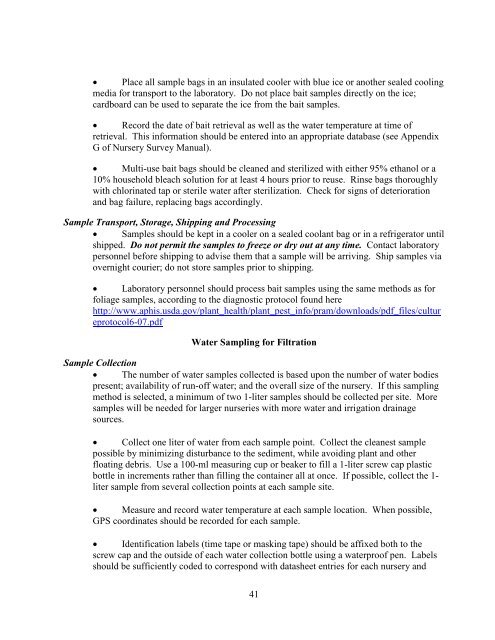Confirmed Nursery Protocol - aphis
Confirmed Nursery Protocol - aphis
Confirmed Nursery Protocol - aphis
Create successful ePaper yourself
Turn your PDF publications into a flip-book with our unique Google optimized e-Paper software.
• Place all sample bags in an insulated cooler with blue ice or another sealed cooling<br />
media for transport to the laboratory. Do not place bait samples directly on the ice;<br />
cardboard can be used to separate the ice from the bait samples.<br />
• Record the date of bait retrieval as well as the water temperature at time of<br />
retrieval. This information should be entered into an appropriate database (see Appendix<br />
G of <strong>Nursery</strong> Survey Manual).<br />
• Multi-use bait bags should be cleaned and sterilized with either 95% ethanol or a<br />
10% household bleach solution for at least 4 hours prior to reuse. Rinse bags thoroughly<br />
with chlorinated tap or sterile water after sterilization. Check for signs of deterioration<br />
and bag failure, replacing bags accordingly.<br />
Sample Transport, Storage, Shipping and Processing<br />
• Samples should be kept in a cooler on a sealed coolant bag or in a refrigerator until<br />
shipped. Do not permit the samples to freeze or dry out at any time. Contact laboratory<br />
personnel before shipping to advise them that a sample will be arriving. Ship samples via<br />
overnight courier; do not store samples prior to shipping.<br />
• Laboratory personnel should process bait samples using the same methods as for<br />
foliage samples, according to the diagnostic protocol found here<br />
http://www.<strong>aphis</strong>.usda.gov/plant_health/plant_pest_info/pram/downloads/pdf_files/cultur<br />
eprotocol6-07.pdf<br />
Water Sampling for Filtration<br />
Sample Collection<br />
• The number of water samples collected is based upon the number of water bodies<br />
present; availability of run-off water; and the overall size of the nursery. If this sampling<br />
method is selected, a minimum of two 1-liter samples should be collected per site. More<br />
samples will be needed for larger nurseries with more water and irrigation drainage<br />
sources.<br />
• Collect one liter of water from each sample point. Collect the cleanest sample<br />
possible by minimizing disturbance to the sediment, while avoiding plant and other<br />
floating debris. Use a 100-ml measuring cup or beaker to fill a 1-liter screw cap plastic<br />
bottle in increments rather than filling the container all at once. If possible, collect the 1-<br />
liter sample from several collection points at each sample site.<br />
• Measure and record water temperature at each sample location. When possible,<br />
GPS coordinates should be recorded for each sample.<br />
• Identification labels (time tape or masking tape) should be affixed both to the<br />
screw cap and the outside of each water collection bottle using a waterproof pen. Labels<br />
should be sufficiently coded to correspond with datasheet entries for each nursery and<br />
41
















